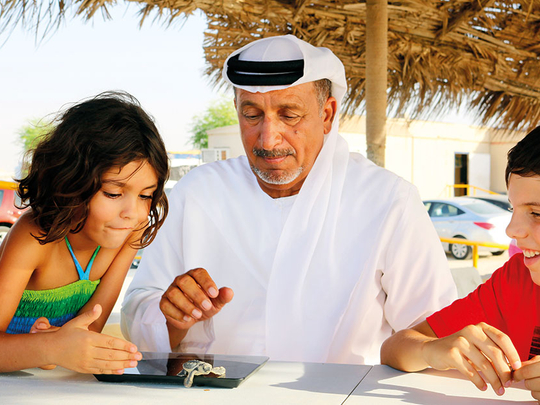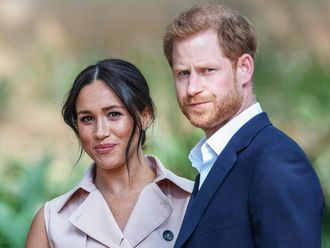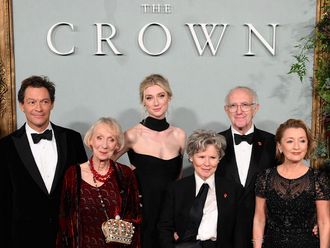
When the producers of Wild Dubai, Discovery Channel’s new documentary about wildlife in Dubai, first got a call from the Government of Dubai Media Office to collaborate, they were unsure. Would there be enough animals to film in a cosmopolitan city? What they found astonished them. There was enough not just for one, but several films.
Wild Dubai, a 40-minute documentary, will premiere on October 9, showcasing various animals in their natural habitats, as well as traditional practices in the region, from camel racing to falconry.
Gulf News tabloid! watched the film on Tuesday and sat down with British director David Johnson and executive producer Martha Holmes to find out what went into its creation. Here’s what we learned.
1. Wild Dubai is set in four locations
The coast, the desert, a wetland in Ras Al Khor and the Hatta mountains south-east of central Dubai. To hear director David Johnson say it: “There’s a bigger diversity of ecosystems within Dubai than one might imagine on first inspection.” Each area is home to different species of wildlife. Flamingoes are found in Ras Al Khor, while Hawksbill sea turtles are found on the coast. Bats, spiny-tailed lizards, Arabian horned vipers and the once-extinct Arabian oryx are in the desert, while the Arabian tahr appears from time to time in the lonely Hatta mountains.
2. The filmmakers were hesitant to take it on
Martha Holmes, a Bafta Award-winning BBC Television producer and broadcaster, was hesitant when she first got a call from Government of Dubai Media Office to collaborate. She had a very different idea of the emirate.
“Dubai, as naive as I was, or as ignorant as I was, was a 21st century city, and I was concerned that we wouldn’t get enough wildlife to fill the show. As it turned out, we could have made more shows because there’s so much going on,” Holmes said. That’s when director Johnson came on board. “We both quickly realised that we were going to be fine and it was going to be an easy story to tell.”
3. It covered 15 species, but even more were left on the cutting room floor
Johnson wanted to surprise not only foreigners, who might associate Dubai with things such as shopping or architecture, but people who have been living in the UAE their whole lives. “There’s a lot of wildlife here, not necessarily in numbers, but in terms of diversity and in terms of the species,” said Johnson. “I was very keen on reflecting that there are lots of different species… You’ve got mammals, you’ve got birds, you’ve got reptiles, you’ve got amphibians.”
4. The film uncovers an unusual turtle rescue operation that runs out of Burj Al Arab
The Dubai Turtle Rehabilitation Project team has been working from the Burj Al Arab since 2004 to capture, rehabilitate and release any sick or injured sea turtles back into the wild. This includes the administration of antibiotics and operating on the animals.
For Holmes, who is a marine biologist by training, these efforts were extraordinary. “The rehabilitation of individual baby turtles when they’re one year old, when they come into the hotel with all those barnacles on them — each turtle is so key, because the global population of Hawksbill [turtles] is seriously under threat,” she said. “To take yearlings, bring them in, nurture them back to health, keep them until they’re fully healthy and ready to be at sea again, I don’t know of anywhere else that does that.”
5. It follows the first animal to ever revert from its extinct-in-the-wild status
The most fascinating animal for director Johnson was the Arabian oryx. It was the first animal to revert to vulnerable status after going extinct in the wild in the 1970s. Through rescue efforts in zoos and private reserves around the world, the Arabian oryx was reintroduced into its natural habitat in 1980. “To be able to see that animal in its natural environment, that was a real thrill and very exciting,” said Johnson.
6. They had to take into consideration Dubai’s heat and its more dangerous terrain
“You need to take into consideration not just the wildlife but the environment that you’re in; if you’re out in the desert, make sure you got lots of water, and make sure you cover up,” said Johnson.
The team was meticulous in planning their climbs up mountains and narrow pinnacles in the Hatta region, making sure they had the appropriate equipment and knew what they were doing. “It’s about managing risk, really,” he said.
7. It captures the stunningly vibrant flamingos of Ras Al Khaor
Despite an overwhelmingly sandy and muted colour palette throughout the documentary, there’s a bright splash of pink when the filmmakers pan to the little-known wetland of Ras Al Khor. There, a flamboyance of flamingoes show off their beautiful feathering. An interesting fact from the film: these birds gain their vibrant hue from what they eat, such as algae and shrimp. That’s why the younger flamingoes, who haven’t been on the flamingo diet for long, are a more lackluster white-and-grey.
8. The biggest obstacle to the film was the animals themselves
The documentary took seven weeks on-and-off to film, and the biggest question on Johnson’s mind was: “Is the wildlife going to turn up when you’re there with the camera?”
The crew came out to the UAE on three separate occasions, to get a sense of Dubai’s animal population during different seasons.
“In May, a lot of things are out, possibly breeding or migrating North. Everything slightly shuts down for the summer. [It’s] too hot, really. And then things pick up again in the autumn-winter. Spring, I would say, is probably the best,” said Holmes.
9. The documentary is the combination of two stories pitched by the filmmakers
Initially, they considered following the animals throughout the different seasons, but ended up with another narrative. “The story, for us, was much more [about] wildlife, people, conservation and culture. It was kind of making that jigsaw work. The original pitch, the two stories were: land and sea. But we decided to combine the two and make one,” said Holmes.
10. The filmmakers would love to do another one
“We would love to,” said Holmes. “I think there would need to be a bit of a gap before we come back and do another just pure wildlife conservation show. But there’s certainly more material.”
__
Don’t miss it!
Wild Dubai will premiere on OSN (channel 500) on October 9 at 10pm in the UAE. It will also air in other regions of the world.













